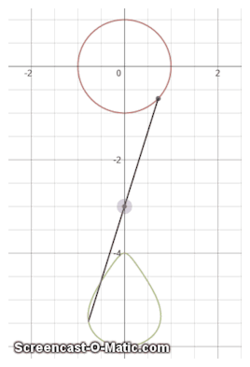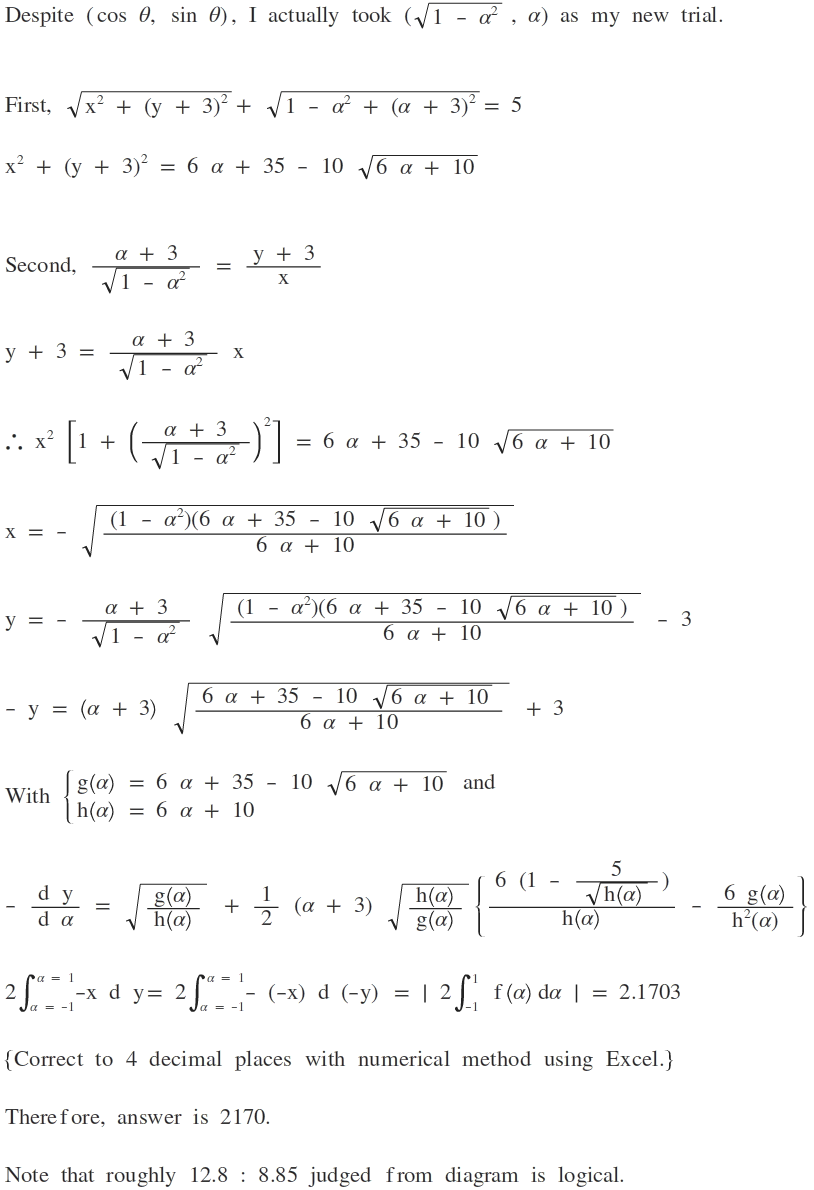Seeu Sim's Leg


The above is a GIF showing the mechanism of a very simple but impractical leg. However, in maths, nothing is impractical.
It is known that the red colour circle above is of radius 1 .
The coordinates of the purple point are ( 0 , − 3 ) .
And the length of the black line (or leg) is 5 .
The green egg-shaped shape traces the path of the bottom of the black leg.
Given that the area of the green egged-shaped shape is A , find ⌊ 1 0 0 0 A ⌋ .
To be fair, you may use a computational method.
Try my Other Problems
The answer is 2170.
This section requires Javascript.
You are seeing this because something didn't load right. We suggest you, (a) try
refreshing the page, (b) enabling javascript if it is disabled on your browser and,
finally, (c)
loading the
non-javascript version of this page
. We're sorry about the hassle.
2 solutions

Sir, I'm quite happy to see a L A T E X solution from you ⌣ ¨ ? And well explained too,sir . +1
Log in to reply
Did you find a non-numerical method to solve this question?
heres the simulation to play with.
Log in to reply
Counting pixels can be more accurate. Thanks for setting this question. Both x and d y in this integral ought to be varied, which is not usual. How do you solve this question?
Log in to reply
Pretty much the same way
Log in to reply
@Julian Poon – I assume you mean that you have also applied numerical method. Thanks.
you have made my day,I used vectors hence typing is too hard but i can say the steps
1)take a random point on the circle that is vector A= (cos t,sin t)
2)consider point(0, -3) as vector B
3)take B-A to get the direction we need
4)now make B-A a unit vetor by dividing...by magnitude .Let this new vector be H
5)now multiply by 5 to this unit vector to get 5H
6)add this to A and get the pints on our required eyedrop that is A+5H
7)take x and y component separately and u will get
x= cos(t)-5cos(t)/(10+6sin(t))^0.5
y=sin(t) - 5(3+sin(t))/(10+6sin(t))^0.5
8)next integrate using symmetry about y axis that is ANS is
2*definite integral (-pi/2 to pi/2) x dy ......ydx is quite hard here but not impossible
9)use wolframalpha for easy calculation that is type this into it
2*definite integral (-pi/2 to pi/2)
( cos(t)-5cos(t)/(10+6sin(t))^0.5 )d( sin(t) - 5(3+sin(t))/(10+6sin(t))^0.5 )/dt
10)OR click this link
http://www.wolframalpha.com/input/?i=definite+integral+-pi%2F2+to+pi%2F2+%28+cos%28t%29-5cos%28t%29%2F%2810%2B6sin%28t%29%29^0.5+%29d%28+sin%28t%29+-+5%283%2Bsin%28t%29%29%2F%2810%2B6sin%28t%29%29^0.5+%29%2Fdt
Nice solution :). Did it more or less the same way...It took me about 10 minutes to type out the definite integral in wolfram alpha!...
Makes one wonder that if this is a 'simplistic' model of a leg, what the associated math of a 'realistic' model would look like. :D
Hi, I used a similar method . Actually I was thinking whether to solve the definite integral or use WA but I guess everyone around here knows where to go ⌣ ¨ .
+1
Is this numerical method or not?